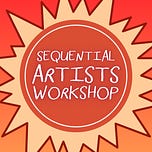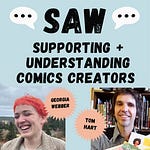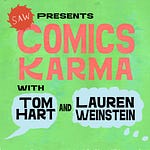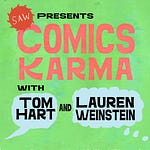This week’s Terrible Anvil we talk about CHOOSING IDEAS and then LETTERING
We talked a lot about IDEAS as SPELLS, and that ideas assert themselves. And Ideas are invitations to act. But they don’t all have to be acted upon. They come and they go.
We answered from the crowd: If you have too many ideas whirling around your head, what's a good way of picking one out to work on?
and
How do you reconcile what’s in your head and what you put on paper?
--------------------------------
The Terrible Anvil!
How do you make comics without all the frustration? Without feeling lousy and inadequate all the time? With the Terrible Anvil of daily deadlines! And a community, and mindset shift about what it means to make comics and art. Jess Ruliffson and Tom Hart are working through the whole process, one piece at a time, turning frustration into fun and glee.
💬ONLINE COURSES SAW is a SCHOOL with loads of online courses you can see here: https://learn.sawcomics.org/
💬COMMUNITY REMINDERS! You can also join hundreds of people sharing their work at our free members site
https://members.sawcomics.org/share/F6BBQeyGUGE0g-Qk?utm_source=manual
💬 DONATIONS Thanks so much for being here! SAW Comics is a 501C-3 non-profit and we thrive on your support and donations! You can support these workshops, plus the many many ways in which we strive to meet our mission of training and supporting graphic novelists.
You can support us on Patreon or PayPal, here: https://www.paypal.me/comicsworkshop
https://patreon.com/sawcomics
Venmo: sequentialartists-workshop Or become a sustaining donor: https://learn.sawcomics.org/courses/saw-sustaining-member-donation
Recorded at SAW on Zoom, Feb 2024
THANKS!
What follows are Jess’s recap and then the ZOOM AI recap….
JESS’s RECAP
We were answering two good questions this week about IDEAS and also we FINALLY talked a little bit about lettering.
Deanna asked:
If you have too many ideas whirling around your head, what's a good way of picking one out to work on?
My friend Fionnuala at the University of Edinburgh asked:
How to reconcile what’s in your head and what you put on paper?
Some highlights from the call chat:
Our ideas----->
I'm a bit of a hoarder when it comes to ideas- Tom
Also Tom: I have two answers: randomness and cards, but also--ideas are bossy!
Carole McKee Armen:
Ideas choose me
Leonie Sharrock:
sometimes I have to wait for another idea to trigger an old idea into life … like one idea finds its soulmate idea, then we're cooking!! 😀
Jess thinking about the astonishing ideas vs the ordinary ones
Tom: Sometimes am worried ideas my skitter away - putting it off might release it of its creative charge, which is a little sad. ideas are like spells that wear off re: a lot of our mental attachments are spells and they fade
From Maria Fitzgerald:
Maybe some ideas are just perfect for how you think at a certain time, but then as time goes by your thinking changes.
Jess: ideas like fireworks, ideas that are like bossy siblings
Sometimes many ideas live in your book draft. Then you realize 2 are a book, 1 is a different book. As you work, things become more clear
An idea is an invitation to act - Tom Hart
From Donna:
I can’t finish a project until I have an outline (from which to deviate)
Tom mentioned the perils of an old idea that is super mapped out - hard to act on it
From Maria:
I kind of keep my ideas to myself until I get something down on paper…Because talking about an idea is not the same as actually writing it or drawing it yourself.
Carole also said:
Sometimes talking about an idea makes it lose its mojo. Don’t know why…
Tom: sometimes it's ok if an idea is just cool to talk about and you don't make something. Or what about an idea steeped in curiosity, steeped in a question?
Tom says: start wherever you can!
-----Question Two------!
How to reconcile what’s in your head and what you put on paper?
Jim Hamilton:
Falling was a side topic that came up while I was researching a different book. I only became obsessed with it over time.
Tom: we're creatures! We make stuff! (Create-tures?)
I mentioned my love for the competitive baking show, Nailed It! As well as the Trump cake that makes me wheeze with laughter:
Which Tom eloquently paraphrased as: when we try to make the professional art it looks like amateur baking show cake
I wondered:
“Are you inviting the audience in too soon?”
Maria had a good point:
I wonder is it true that the reader gets more involved if they have to interpret the art a little…. if it is not just perfectly representational.
One of our nonfiction students Ellen, said about her work: "I have to have fun doing it!" which is really useful.
Tom shared this quote via Austin Kleon, from Will Oldham:
“Part of the idea in making a record is to freeze lots of moments of learning and discovery so that it really is like every time you press “play” you are opening up this experiment again.”
Tom further opined:
honoring imagination with a certain amount of liveliness - the fun of it is learning and doing something unexpected - rereading it later, can relive that moment, what it was like to discover something
Tom says Try not to separate the process from the final
Jess: as working professionals we forget to have fun
ON THE TOPIC OF FUN--- WHAT ABOUT LETTERING?!
Some Lettering tips:
Don't put it off til the very end
Do leave lots of space
Don’t do long Hindenburg lines of text! (giant ovals of dialogue balloons)
Jess used to be afraid of lettering. But if she does it first she now thinks “wow this looks like a real comic!
Alison Kent asked:
Wondering how many people produce scripts separate from the drawings?
Jim does! (Jim said: But it may not be the kind of script you are asking about. I lay out the text for each page and then trace it before adding drawings.)
Jess mentioned: if i have a clear script, lettering is WAY easier too! Sometimes the fear of lettering is the fear of clarifying the script
Tom asked: What is the lettering for? Communicators/creatures - it doesn't have to look a certain way - don't fall into the trap of using Arial font and not being specific - treat the lettering like it's part of the work (or communication/expression of the work)
Can generate your own font here at Calligraphr (thanks Adrean!)
Good resources out there for lettering! For example (Nate Piekos' BLAMBOT!)
Alison Kent:
Re: scripts — I heard a podcast about making comic book scripts and this gives client a good sense of what’s going to be there before you spend 3 years drawing. (Or before the client gives you a contract)
Adrean added:
I think sometimes we research things too much when we really should be playing and experimenting with it. Things like lettering, etc — requires “do it” time to build up the skills and knowledge
Tune in for next week's episode: PITCHING!
From Sally Charette:
How about talking about pitching since pitching for the next FLOW anthology is coming up? (TROUBLED HISTORIES)
ZOOM Quick AI recap
The discussion between Jess and SAW Comics focused on the challenges of creativity, idea generation, selection, and execution. They shared their experiences of working on their podcast and book, "The Bootleggers Guide to Comics", and the process of crafting Tom's memoir. They also touched upon the importance of enjoying the creative process, not taking oneself too seriously, and the significance of lettering in comics. Towards the end, they decided on the topic for their next meeting, which is how to pitch ideas more effectively.
Summary
Podcasting and Idea Generation
Jess and Tom had a detailed discussion about the content of their podcast, focusing on the topic of lettering which was decided to be postponed. They addressed questions from their audience, including one from Deanna Feinstein about handling too many ideas, and another from a friend at the University of Edinburgh. They shared their experiences with idea generation and selection, and the challenges of finding ideas, especially when faced with deadlines. Jess and SAW Comics, also known as Tom, also discussed their process of crafting a book titled "The Bootleggers Guide to Comics", using a podcast to workshop ideas and setting weekly check-ins to keep progress on track. They concluded the discussion by sharing their idea generation and selection process for Tom’s memoir.
Ideas and Creative Processes
Jess and Tom had a lively discussion about the nature of ideas and their creative processes. They shared their experiences of having multiple ideas and the challenge of deciding which ones to pursue. They agreed that not all ideas are awesome and sometimes need to be separated. They also discussed the thrill and excitement of having a new idea, often even more than the final product. They emphasized that an idea can exist in various forms, including as a conversation, and wondered about the conventional structure of novels. They also touched upon the challenges of maintaining motivation and focus when working on a project. Towards the end, they discussed the sensitivity and privacy associated with creative ideas, and the importance of keeping some ideas to oneself to preserve their magic.
Creative Process vs. Expectations
The meeting revolved around a conversation between SAW Comics and Jess on the challenges of reconciling ideas in one's head with their execution on paper. SAW Comics shared his perspective, emphasizing the importance of being present and curious in the creative process, rather than adhering to expectations or preconceived notions. Jess agreed and tied this into a previous conversation they'd had about the satisfaction derived from the process of creation rather than the product itself. The discussion was punctuated by Jim's input on a different question via the chat.
Nailed It!: Inspiring Lighthearted Creativity
Jess and SAW Comics had a conversation about the Netflix show "Nailed It!", which is hosted by Nicole Beyer and Jacques Torres. The show involves amateur bakers attempting to construct elaborate cakes under pressure. Jess drew parallels between the show's lighthearted approach to baking and their creative processes, emphasizing the importance of not taking oneself too seriously and embracing the joy of the process. SAW Comics noted that the show is full of laughter and joy, and shared how the concept of side projects has influenced their work, mentioning Megan Kelso's shift towards short stories after realizing their potential.
Creativity, Joy, and Balance in Artistic Process
Jess and SAW Comics had a discussion about the importance of enjoying the creative process. Jess shared her personal struggle with taking her art too seriously and how she found joy in making it a bit silly. She highlighted the importance of maintaining a childlike mindset and not being too critical of the outcome. They explored the challenges of balancing self-acceptance and self-improvement in their work. SAW Comics emphasized the importance of capturing moments of learning and discovery during the creation process. The conversation also touched upon the idea of monetizing their work, and how it can sometimes lead to a more transactional approach rather than being driven by curiosity and enjoyment.
Lettering in Comics: Artistic Expression and Communication
Jess and SAW Comics discussed the importance of lettering in comics, emphasizing that it should not be overlooked. Jess shared her method of creating layouts to show editors quickly, using a font generator based on handwriting. SAW Comics added that lettering is a form of communication and a part of their artistic expression, rather than just a decorative element. They also reflected on the significance of lettering in their earliest drawing experiences and proposed that recalling these experiences could be beneficial.
Comics Lettering and Scripting Discussion
SAW Comics and Jess explored the topic of lettering in comics, discussing how it reflects personality and the challenges of conveying meaning beyond conventional letters. Jess suggested that fear or avoidance of lettering might be linked to unclear scripts. They agreed that there are various styles of lettering that can effectively communicate ideas. Jess also discussed her interest in creating clean scripts, emphasizing the importance of designing panels and determining the appropriate word count. She shared her preference for clear parameters on scripts, like length and medium, to guide her creative process. Jess concluded by suggesting a possible episode about pitching short form comics or a book proposal.
Work, Experiment, Pitch: Importance and Effectiveness
The discussion also touched on the importance of doing the work and experimenting rather than just researching. Towards the end, they decided on the topic for the next meeting, which is how to pitch ideas more effectively, in light of an upcoming anthology.
Next steps
Jess and SAW will revisit the topic of their book, The Bootleggers Guide to Comics, and discuss how to work on it more effectively. They will also consider the topic of pitching for the next anthology and how to make ideas more actionable.
THANKS!
















